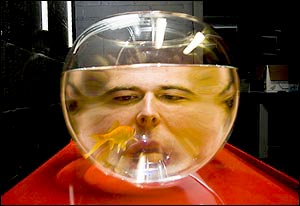MANCHESTER, England, Oct. 23, 2007 -- Goldfish have a natural advantage in sensing the proximity of their meals: Individual light-sensitive cells in their retinas are able to detect polarized light, acting much like Polaroid sunglasses.
This type of polarized vision improves visual contrast and can help an animal catch its prey more easily, said Nicholas Roberts of Manchester University’s Photon Science Institute and its School of Physics and Astronomy. His research is the first direct experimental evidence of a polarization detection mechanism in any normal vertebrate eye. The research team believes that discovering how single cells work as polarization detectors may lead to new developments in man-made microscopic detection or information display technologies.

Polarized vision could aid navigation. (Photo courtesy University of Manchester)
"Vision is the primary sense of many animals, and the way they see their world is of fundamental importance to understanding aspects of their behavior," Roberts said. “Numerous animals have amazing visual abilities, which allow them to see the world in very different ways."
One such ability is polarization vision. “Just as fishermen wear Polaroid sunglasses to help improve contrast, many different animals – including fish – have evolved to do the very same thing without the need of sunglasses. It is a surprisingly common ability throughout the animal kingdom,” he said.
For the study, Roberts used "laser tweezers" to manipulate the cells in three dimensions. This meant that for the first time, the absorption of single photoreceptors could be studied in the same orientation in which they are in the retina. He stressed that the team has so far only investigated one of the three-color channels known to play a role in polarization vision.
"This is just the first step in understanding the full mechanism that allows vertebrates to see polarized light, but we see these initial results as extremely encouraging," he said. “We are now examining in much greater detail the underlying biochemical properties that make only some photoreceptor cells polarization detectors."
The real challenge, he said, is building an integrated picture of vertebrate vision. "We are aiming to discover how both the biochemical and biophysical aspects of visual cell function link to the way polarization information is first analyzed, processed and then relayed to the brain."
The paper, "A Mechanism of Polarized Light Sensitivity in Cone Photoreceptors of the Goldfish Carassius auratus," is in the November 2007 Biophysics Journal (volume 93).
For more information, visit: www.eps.manchester.ac.uk